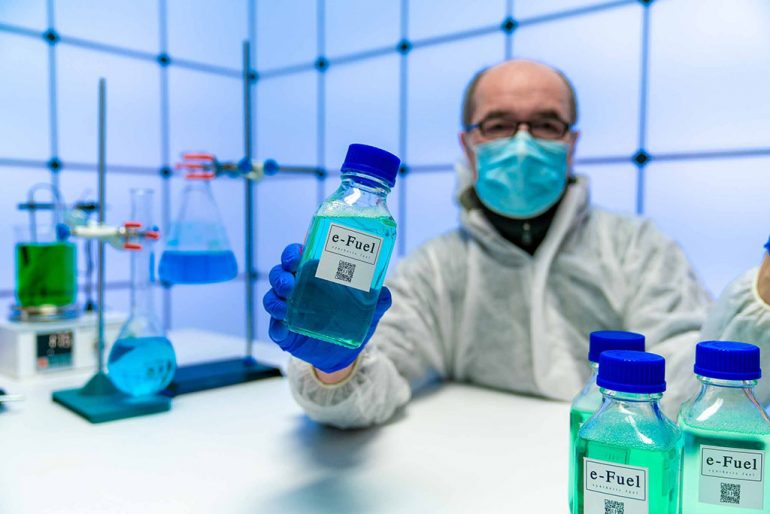
Porsche has recently made a significant investment of $75 million in a company based in Chile that specializes in the production of e-fuel. The renowned automaker is actively exploring alternatives to traditional combustion fuels in order to maintain the unique character and performance of its iconic sports cars.
E-fuel, a potential replacement for gasoline and diesel, has attracted the attention of Porsche, along with other prominent automakers such as Stellantis, Ferrari, and BMW. This innovative fuel is created by combining carbon dioxide extracted from the atmosphere or captured at refineries with hydrogen derived from water through electrolysis.
Also, don’t forget that you can get discounted new car pricing with a free quote through qualified local dealer partners.
The appeal of e-fuel lies in its ability to enable internal combustion vehicles to operate with nearly the same level of cleanliness as electric vehicles (EVs), without requiring extensive modifications to engines, fuel injectors, or emissions systems. Micky Bly, Stellantis’ head of global propulsion systems, emphasized that the approach should be centered on using e-fuels for engines rather than modifying engines for e-fuels. Stellantis has conducted testing and validation of e-fuel in various gasoline and diesel engine families spanning almost a decade.
While automakers affirm the compatibility of e-fuel with existing engines, refiners face the challenge of developing cost-effective manufacturing methods that can rival gasoline production. According to a recent study by the International Council on Clean Transportation, e-fuel could cost more than $11 per gallon if it were currently available. Companies like Shell, Exxon, Aramco, and other smaller refiners are actively engaged in the development of e-fuels.
In North America, domestic automakers heavily rely on the profits generated by large pickups and SUVs to finance the electrification of their vehicle lineups. However, due to limitations in battery-electric powertrains, particularly in terms of towing capacity, these automakers are still exploring alternatives. In Europe, luxury automakers like Porsche and Ferrari are also considering e-fuels to preserve the performance and character of their sports and exotic cars, as battery packs, limited driving ranges, and long recharging times could undermine their appeal.
Comparing internal combustion engines with electric drivetrains in larger vehicles, such as General Motors’ Chevrolet Suburban and GMC Hummer EV, reveals the advantages that combustion engines currently possess. The Suburban, equipped with a turbodiesel six-cylinder engine, boasts an EPA-rated 26 mpg on the highway and a range of 728 miles with a 28-gallon fuel tank. On the other hand, the GMC Hummer EV offers a range of 314 miles on a single charge, requiring nearly an hour for a full recharge using a DC fast charger. The effects of hauling extra weight are more pronounced in EVs, making it challenging for automakers to commit to building electric heavy-duty pickups.
Despite these challenges, GM recently announced the next generation of its small-block V-8 engines and internal combustion-powered heavy-duty pickups and big SUVs, representing significant investments totaling nearly $2 billion across four plants. While the automaker acknowledges the potential of low-carbon and net-zero carbon fuels in reducing emissions, it remains committed to the electrification of its light-duty fleet.
However, the widespread availability of e-fuel at public stations is still a distant reality. Refiners must overcome various obstacles, such as perfecting large-scale production methods at a comparable cost to gasoline and addressing issues like water scarcity and the need for renewable electricity sources. Bentley CEO Adrian Hallmark acknowledges the exciting progress in e-fuel development but expresses skepticism about achieving net-zero carbon emissions within an acceptable timeframe.
One advantage of e-fuel is its compatibility with existing infrastructure and internal combustion engines. Automakers emphasize that e-fuel can serve as a direct replacement for gasoline without requiring significant modifications to engines, fuel systems, or emissions systems. Greg Davis, a mechanical engineering professor at Kettering University, confirms that minimal changes, such as calibration adjustments, would be sufficient. This compatibility is crucial as most of the product development funds are currently directed towards the transition to EVs.
Speakers at the SAE International panel also agreed that internal combustion vehicles running on e-fuel could achieve comparable cleanliness to battery-electric vehicles. However, it is important to note that e-fuel does not eliminate emissions entirely, as it aims to be a carbon-neutral fuel. This means that the amount of CO2 produced during its production and transportation must be equal to the CO2 it helps reduce. To achieve this, renewable sources such as wind turbines, solar panels, or hydroelectric dams must provide the electricity necessary for hydrogen separation.
Another potential clean fuel for internal combustion engines is gaseous hydrogen produced using renewable sources. While an engine can burn gaseous hydrogen with minimal modifications, its lower energy density compared to fossil fuels remains a drawback. Hydrogen fuel cells, on the other hand, are considered a viable option for larger trucks, as they offer towing capabilities suitable for three-quarter-ton pickups.
Source: AutoNews (subscription required)